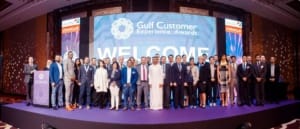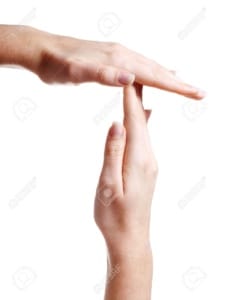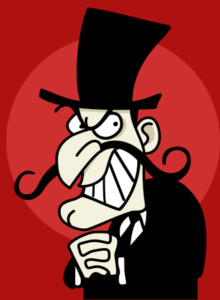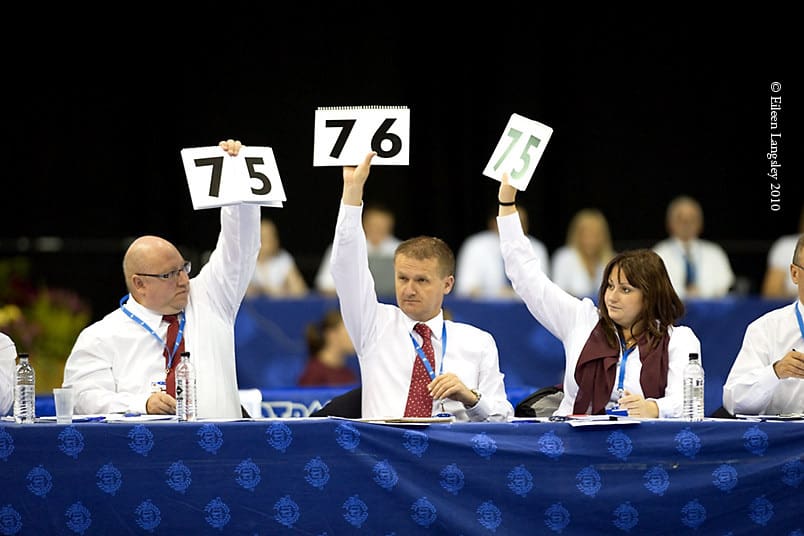What lessons can Contact Centre folks can learn from CX folks?
I’ve written about lessons CX folks can learn from Contact Centre folks.
Here’s a link to my earlier article:
Today I flip the perspective and ask – what lessons can Contact Centre folks learn from CX folks?
Because the nature of the work between the roles is different – no matter how much Contact Center folks rebrand themselves as Customer Experience.
And there are so many lessons Contact Centre folks can learn from their CX Colleagues.
Here goes!
Is the work done in CX and in Contact Centres really so different? Yes it is. 
When people ask me about what it takes to run a successful Contact Centre, I like to use the analogy of a circus tent.
Imagine a traditional red & white striped circus tent up ahead of you. Lots of things are going on inside that big top.
As you enter the tent you’ve got the high-wire acrobats up overhead, the lion tamers over there and the clowns driving around in funny cars in the ring by the entrance.
There’s a lot going on in that tent. And it all matters. The Fortune Teller has her role. The Weightlifters have their role.
You get the idea.
Now imagine that your big top tent is your Contact Centre. There’s a lot going on inside the Contact Centre big top too.
When you walk inside you’d find Quality Assurance – that’s a specialized role.
And as we look around we’d find Workforce Management, Training, IT, Human Resources, Finance. They’re all specialized roles too.
They’re all contributing to Contact Centre success.
And of course you’d have all the people that get the work in and out each day – the Agents, the Team Leaders, the Directors.
In a great Contact Centre all these disparate roles work in harmony together to achieve results. Everyone knows what everyone else does and has a basic understanding of each other’s contribution to success.
All under the direction of a skilled & knowledgeable Contact Centre Head.
But the Contact Centre tent isn’t the same as the CX tent.
So what’s inside the CX tent?
Like the Contact Centre tent, there’s a lot going on inside the CX tent too.
Let’s walk over to the CX big top.
I teach Customer Experience Management and help people earn their CCXP Certification. And competencies that I cover in our training would be found in the CX tent including:
· Customer Experience Strategy
· Voice of Customer & Customer Research Know-How
· Experience Design
· Metrics, Measurement & ROI
· Culture & Change Management
And each of these are big topics.
Just consider Voice of Customer & Customer Research Know-How.
By the time you factor in qualitative & quantitative research methods, triangulation, prioritization, data analytics and reporting & actioning of results you’ve covered a tremendous amount of ground.
And just like in the Contact Centre, the disparate CX roles work in harmony under the direction of a skilled & knowledgeable CX Head.
With the added complexity that CX is at play across the entire organization. All functions, all departments, all Employees, all Partners, all Vendors.
Everyone in the Customer ecosystem.
When I listen to people talk about their work I ask myself – are they talking about the work that falls within a function or department – like Customer Service?
Or are they talking about work that spans the organization – such as lifecycle and journey analysis, rollout of listening posts and organization wide culture change.
How they describe their work provides input into whether they work in Customer Service/Contact Centre or they work in Customer Experience.
https://www.omnitouchinternational.com/cx-lessons-i-learned-judging-cx-awards-this-year
Ok, the tents are different. You made your point. So what can lessons can Contact Centre folks learn from CX professionals?
I continue to be inspired by the level and maturity of CX work being done out there in the real world.
And the lessons Contact Center professionals can learn from CX professionals are powerful. Lessons they can use to make their Contact Centres better.
For this article I’ve selected five lessons that stand out for me.
1. How to craft a CX Vision
I am endlessly blown away by the work that CX professional put into crafting a powerful CX Vision.
We teach the process and quite a few Clients have shared the outcome of their process with us. It’s intensive and can take months.
Because it involves aligning to business strategy, brand values and Customer expectations.
And then blending all of these into a powerful statement that defines – specifically – what kind of experience we deliver around here.
It’s so much more than asking ‘what’s the industry standard for this or that’ – which seems to be a trap some Contact Center folks fall into.
Strategy flows from Vision – so getting that Vision right – and taking the time & effort to craft one that’s meaningful is something CX people do – and do well.
If your Organization already has a robust CX Vision, that’s wonderful. You can use that to help you guide and inspire the Service folks that work for you.
If not, then you have the golden opportunity to be strategic – and craft your own Customer Service Vision.
2. Tie strategy to business results
Even after more than two decades years of teaching in the industry, you’re still hearing consultants & practitioners debating whether Contact Centres are cost centers or profit centers.
I know it’s an important discussion – I’ve been in a few myself. I’m not minimizing the importance.
But really? 20+ years? Why hasn’t more progress been made here? (and likely a topic for another article).
What the best CX folks are getting right these days is aligning the CX strategy they come up with to the overall business strategy and key measures of success.
And showing senior management and their peers in other functions how and where CX can improve the business.
Not at the expense of Customers (that’s not CX). Or pushing or tricking Customers into doing what we want them to do.
But in that wonderful intersection where it’s good for the Customer and good for the Organization.
It would be superb to hear more Contact Centre folks talk about their alignment with business strategy and key measures of success. And great CX people can help a lot here – even if they aren’t Contact Centre experts per se.
3. Start thinking in Customer journeys and not just in touchpoints
Contact Centres, by the nature of the work they do, are focused on what happens within the context of a Customer interaction.
On that call, email or chat, did we show empathy, did we solve the problem, did we use time well.
And mastering the Contact Centre touchpoint and delivering great conversations with Customers takes a lot of know-how and skill.
There’s no diminishing the power of getting this right.
But that means that in the Contact Centre, we tend to think in touchpoints and not in the totality of the Customer journey.
Which means that we’re missing the big picture. And the opportunity to make Customer lives better.
It’s proven that Customers think in journeys. And that Organizations that study and improve at the journey level do better than those that focus at the touchpoint level.
So in addition to mastering that ‘touch’ the Customer has with us – that chat or email – it helps for Contact Centre to consider what I call the Journey perspective.
When I teach Customer Service for Frontline folks, I often ask them to think about these questions:
1. Where did that Customer come from – and what motivated them to reach out to us? (the before)
2. What does this Customer need from me right now in this touch? (the during)
3. Where will the Customer likely go or need to go next – and how can I help them with the next steps on the way to their goal? (the after)
I like to cover this when I teach Frontline Customer Service because I think it’s important to use a broader journey oriented ‘lens’ to consider what Customers are going through.
Over and above dealing with a single ‘touch’.
4. Understand Voice of Customer Research practices & principles better
I was taken on a Centre tour a few years ago where the Director was so proud that the individual NPS scores given by Customers at the end of their calls were instantly flashed on large TV screens posted throughout the Centre.
All showing the Agent Names and the scores they had received so far that day.
Oh dear. So demotivating and so wrong. And a classic example of just because you can do something doesn’t make it the right thing to do.
Here’s another example.
When I ask Contact Centre folks the last time they invited in a small panel of Customers, bought them lunch and asked them questions about what they like or don’t like about Contact Centre service, they sometimes look at me like I’m completely nuts.
Bring in a real Customer to the Contact Centre? I’m not exactly sure why that would sound so outlandish. Just imagine how much you could learn.
What kind of Customer experience does your Contact Center deliver?
To be fair, VOC is a highly specialized area.
But having an essential understanding of qualitative, quantitative methodologies, principles and practices can help Centres perform better.
To make better decisions on how they use the data & insights that come out of VOC work.
And avoid poor practices like posting up individual NPS scores.
5. Build cross-functional support
When you listen to CX professionals share their work experience, a common narrative often appears.
It sounds like this:
“I was the first person in my company to take on the CX role – it was brand new. I had to create my own job, determine my own priorities and consider how to achieve both short term and long terms results.
And in all these I had to align myself with other stakeholders in other departments, heads of functions, senior leadership, finance, the COO.
And now – 2, 3, 4 years later I’ve been successful. You know how I know? It’s not just that our Team size has increased – though it has a bit.
And it’s not just that we’ve achieved some cool results – though we have.
It’s that people in the company are starting to come to us – the CX Team. To ask for help. To get our opinion on how to handle something better. To help them solve a business problem.
That’s been the real sign of our success in building the CX practice in our organization.”
Don’t you love that? I know I do.
Contact Centres can only achieve their vision & purpose when they also build and sustain powerful cross-functional relationships too.
Not just to get the basics like forecasting done.
But to promote how the Contact Centre can support the efforts of other departments and solve business problems.
Thank you for reading!
I appreciate the time you took today to read this!
If you’d like to be kept up to date on our articles and other information just leave your email address in the contact form on our website. Or send it over to me by email.
Daniel Ord
www.omnitouchinternational.com






 In this short post I challenge the Reader to answer 10 Quiz questions on Quality Assurance.
In this short post I challenge the Reader to answer 10 Quiz questions on Quality Assurance. Daniel
Daniel

 Formal living rooms may sound old fashioned – but they’re still around.
Formal living rooms may sound old fashioned – but they’re still around. For a University Contact Center, the Agents were instructed to immediately redirect the Caller to the university website if it turned out that the information was available there.
For a University Contact Center, the Agents were instructed to immediately redirect the Caller to the university website if it turned out that the information was available there.  I bet you can imagine what those Agents sounded like when we listened to the calls. Yup that’s right.
I bet you can imagine what those Agents sounded like when we listened to the calls. Yup that’s right.


 When I teach Operations I suggest Participants look at First Contact Resolution as a multivitamin KPI.
When I teach Operations I suggest Participants look at First Contact Resolution as a multivitamin KPI. Push the button and get your Service Level.
Push the button and get your Service Level.
 While your Top 10 changes over time, these enquiries easily represent 60% – 80% of your monthly contact volume (excluding one-off events of course).
While your Top 10 changes over time, these enquiries easily represent 60% – 80% of your monthly contact volume (excluding one-off events of course).

 QA walks over to our station and while we’re talking to a Customer they give us the time out sign. That’s their signal telling us to wrap the call up quickly so they can conduct our side by side coaching session.
QA walks over to our station and while we’re talking to a Customer they give us the time out sign. That’s their signal telling us to wrap the call up quickly so they can conduct our side by side coaching session.


 From Occupancy rates through to Net Promoter Score we have dashboards and dials for everything. (Even though not everything matters.)
From Occupancy rates through to Net Promoter Score we have dashboards and dials for everything. (Even though not everything matters.) We monitor Customer interactions, document our findings and talk to the Agents about their performance.
We monitor Customer interactions, document our findings and talk to the Agents about their performance.

 It tells you how you did.
It tells you how you did.


 “Mr/Mrs. XX, thank you so much for helping me start my day off so wonderfully.”
“Mr/Mrs. XX, thank you so much for helping me start my day off so wonderfully.” And then they Mystery Shopped it.
And then they Mystery Shopped it. Typically I see Small Talk expressed as “Have you had your lunch yet sir?” or “How’s the weather in Singapore today?”
Typically I see Small Talk expressed as “Have you had your lunch yet sir?” or “How’s the weather in Singapore today?” But grafting on Agent behaviours in the hope they deliver a positive Customer Experience shouldn’t involve Agents saying funny things.
But grafting on Agent behaviours in the hope they deliver a positive Customer Experience shouldn’t involve Agents saying funny things.




















 That’s always one of the great things about participating at an Awards event.
That’s always one of the great things about participating at an Awards event. There were 3 key complaint handling practices that I picked up from interacting with all the Complaint Handling Teams.
There were 3 key complaint handling practices that I picked up from interacting with all the Complaint Handling Teams. Their strategic purpose was clear – to understand their Voice of the Customer.
Their strategic purpose was clear – to understand their Voice of the Customer. Equipped with the results of their analyses, the Complaint Handling Team went to their Management to propose changes to processes or rules that caused Customer discomfort.
Equipped with the results of their analyses, the Complaint Handling Team went to their Management to propose changes to processes or rules that caused Customer discomfort.
 Interestingly, many complaints stemmed from questions about bills and statements.
Interestingly, many complaints stemmed from questions about bills and statements. The Customer gets either one point of contact to deal with them all the way through.
The Customer gets either one point of contact to deal with them all the way through. All the Complaint Handling Teams were able to demonstrate a financial ROI to back up their work.
All the Complaint Handling Teams were able to demonstrate a financial ROI to back up their work.








 Daniel
Daniel